Mangala Devi Kannagi Temple Trek
Important Note: This article is a summary of my experience in 2018. Current details of the event/location may be different from what is mentioned in the article.
Introduction
Mangala Devi Kannagi temple is an ancient stone temple located in Idukki district of Kerala near Tamil Nadu border. It is considered to be over 1000 years old and due to its historic significance, the temple is preserved in its original state by the Archeological department of Kerala. It is located in the buffer zone of Periyar tiger reserve and access to the place is restricted by Kerala government.
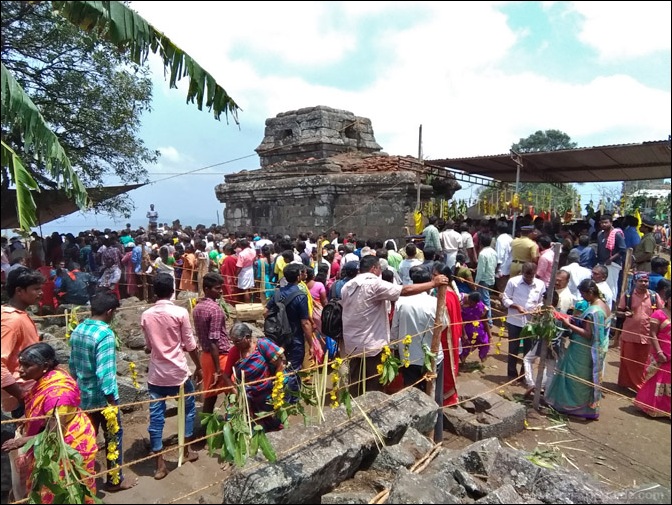
Mangala Devi Kannagi temple is located on a mountain in the buffer zone of Periyar tiger reserve. It is at a distance of 10KM from the Kumily town, Idukki district in Kerala and at a distance of 7KM from Pazhiyankudi, near Lower Camp, Theni district in Tamil Nadu. Trekking is possible from both these places, but jeep access is only available from Kumily town.
Since the temple is located in Periyar tiger reserve, access to the place is restricted. The access to the temple is open to everyone on just one day of the year, the Chithra Pournami festival day of the year. Chithra Pournami is observed on the full moon day of the Tamil calendar month of Chithirai (Medam in Kerala calendar) occurring sometime in April or May. This yearly annual Pilgrimage trek (or jeep trip) is organized jointly by Kerala and Tamil Nadu governments.
The trek to Mangala Devi offers beautiful view of the Kumily town, Western ghats mountain range and the valleys of the Theni district. You can also see the northern sections of the Periyar lake in Thekkady. The area is a rich habitat of animals, but chances of encountering one during the pilgrim trek is very low. The trek is a treat to the nature lover.
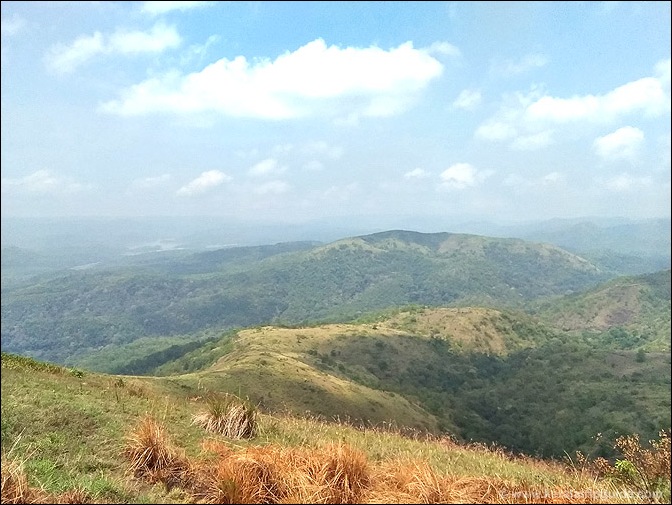
Historical Background – Legend of Kannagi
South Indian language of Tamil is one of the oldest surviving languages of the world. Its earlier forms is considered to be over 4500 years old! According to Tamil literary tradition, there are five great epics of Tamil literature. The oldest one among these is known as the Silappathikaram (The Tale of an Anklet) believed to be composed around the period of AD 100 to AD 400. Silappathikaram is an epic poem containing the story of a brave chaste woman Kannagi, who burnt down an entire town to avenge the death of her husband.
Silappathikaram is the story of Kovalan & Kannagi. Kovalan was a wealthy merchant who married Kannagi. Later Kovalan left his wife for a dancer named Madhavi and spent all his money with her. Kovalan realized his mistake later and returned to his wife. Kovalan and Kannagi decided to start their new life in Madurai. Kovalan tried to sell the precious anklet of Kannagi, but the anklet was mistaken for the stolen anklet of the Queen. Kovalan was accused of the theft and he was beheaded without a trial on the orders of the King Nedunchezhiyan.
Kannagi, furious on hearing her husband’s death, stormed the King’s court. She broke open her other anklet to show that it contained rubies. Thus she proved the the anklet that Kovalan carried is not the same as the stolen one (Queen’s anklet contained pearls). King Nedunchezhiyan realizes that he killed an innocent man. He dies due to heart attack and the queen faints in the court. Still angry, Kannagi sets fire to the palace curtains, which in turn burns down the city of Madurai.
It is interesting to note that Silappathikaram written almost 2000 years ago proposes that even the mighty king is not above the law.
According to legends, Kannagi walked for 14 days to reach near Kumily in Kerala where the temple is now located. It is said that she was reunited with her husband Kovalan and ascended to heavens. The tribal men who saw the event reported it to the Chera King Senguttuvan. As per the stories, Senguttuvan brought stones from Himalayas to build a temple for Kannagi (Mangala Devi). There are also legends that Ilango Adigal, the Jain author of Silapathikaram was Senguttuvan’s younger brother!
Kannagi is considered as a Goddess in many parts of South India. She is also considered as an incarnation of Goddess Bhadrakali in Kerala. Kodungallur Bhagavathy temple and Attukal Devi temple in Kerala are based on the legend of Kannagi.
The Mangala Devi temple structure is built using rectangular shaped granite stones in stacked form. Clearly a lot of human effort was required to bring these giant stones on top of the mountain. The temple construction is in line with that of Pandyan architecture, however, there are no historic records on the origin of the temple. The temple has multiple stone structures which houses idols of Mangala Devi, Karuppaswamy, Shiva and Ganapathy. Since the Mangala Devi temple is in ruins, the idol is usually brought from Cumbum. During the Chithra Pournami, priests from Kerala and Tamil Nadu perform pujas at the temple.
The temple currently is in ruins and is under the protection of archeological department. There are inscriptions on the temple referring to the south Indian emperor, Rajaraja Chola of 11th century. There is considerable political pressure to renovate the temple, however, its location inside the ecologically sensitive Periyar tiger reserve has so far prevented it.
Annual Pilgrimage to Mangala Devi Kannagi Temple
Every year an annual Pilgrimage to Mangala Devi Kannagi Temple is jointly organized by Kerala and Tamil Nadu governments. Facilities for devotees are provided by Mangaladevi Kannagi Trust in Cumbum, Theni and Kannagi Trust in Idukki, Kerala. This Pilgrimage is conducted on the Chithra Pournami day which is the full moon day of the Tamil Chithirai month. This usually is in April or May month of the year. Following are some of the upcoming Chithra Pournami dates,
- 19th April 2019
- 7th May 2020
- 27th April 2021
- 16th April 2022
- 5th May 2023
The following map shows the location of Mangala Devi temple and various routes to reach the mountain top.
There are 3 options to reach Mangala Devi Kannagi temple,
- Trek from Kumily town in Kerala to Kannagi temple. You will trek through the forest covering about 10KM to reach the mountain top.
- Take a jeep from Kumily town. You need to stand in a queue and take a vehicle pass by paying Rs. 90 per person. The distance through the jeep road is around 11KM.
- Trek from the Pazhiyankudi village near Lower camp in Tamil Nadu. You will trek through the shola grasslands covering around 7KM to reach the mountain top. I suggest this route to avoid jeeps and dust. If you are going from Kerala, take a bus to Lower camp from Tamil Nadu check post at Kumily and then take another bus from Lower camp to the village.
On the festival day, the gates to the road are open from 6AM to 5PM. Trekkers can simply walk through the gate towards the temple. Usually there are two checkpoints, first one for checking whether you are carrying any plastics. At the second checkpoint, you need to walk through a metal detector and you will be manually frisked for any weapons. Police and forest guards are stationed along the trekking route.
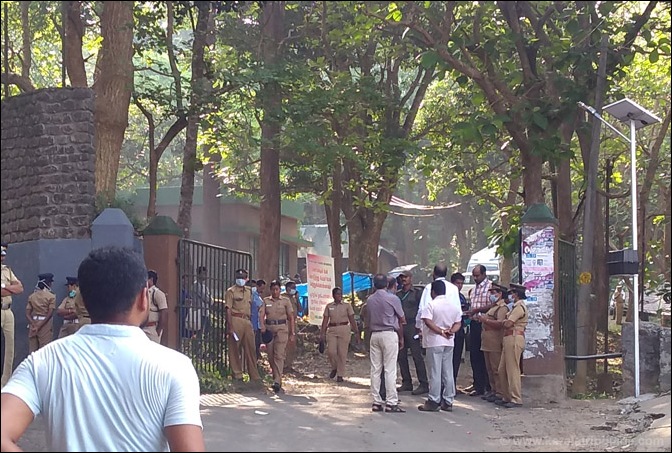
The initial trek route from Kumily is adjacent to the Periyar tiger reserve tourist zone and offers beautiful views. You will also come across artificial water ponds created for animals.

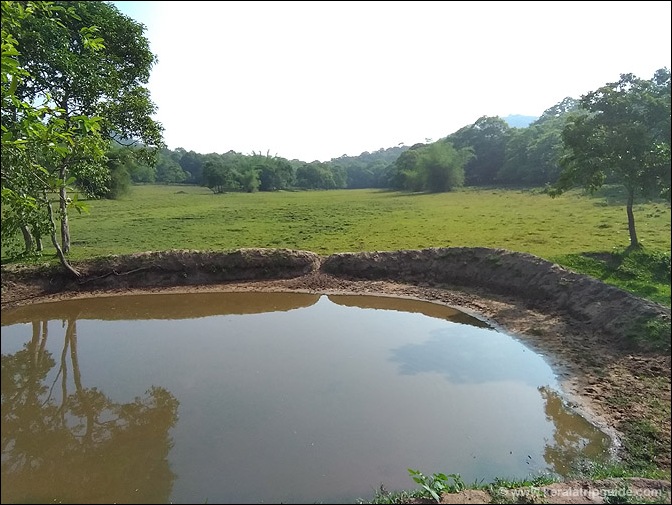
Soon the terrain changes and you will start climbing through thick forest. Plenty of drinking water pipes are available along the way. Beware of jeep drivers who resort to rash driving to complete as many trips as possible. I recommend walking outside the road wherever possible.
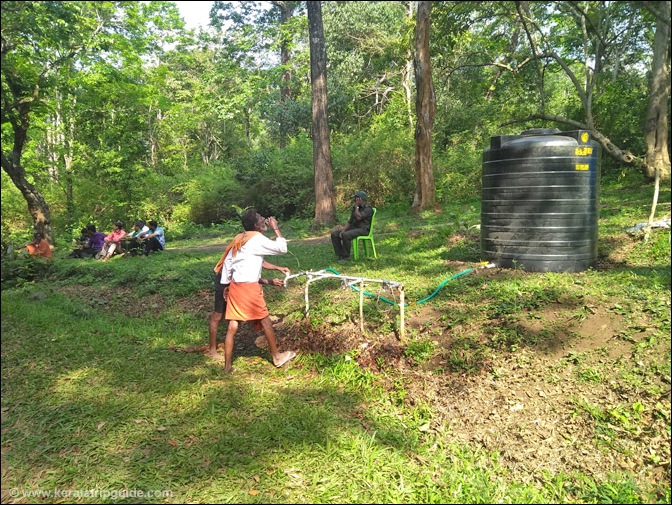
After about 6KM or so you will come across a number of hairpin bends along the way and here trekkers are not allowed to take shortcuts. From here onwards there isn’t much shade and a hat would be useful.
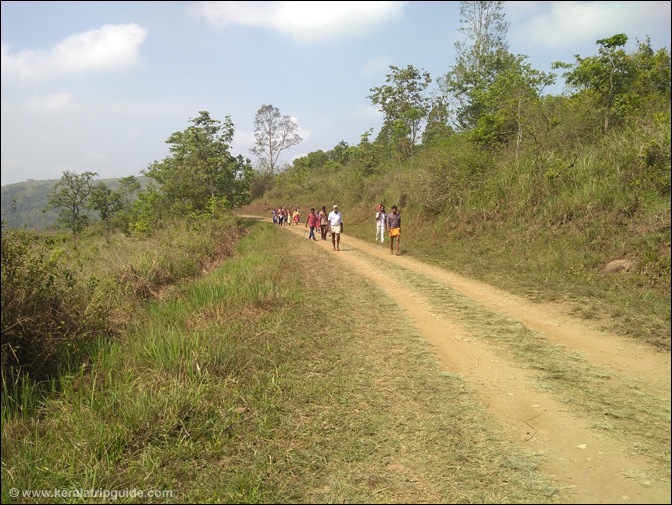
Finally you will reach the shola grasslands area where trekkers are allowed to ditch the road and directly climb the mountain. In the last stretch, a winding road takes you to the top of the mountain where the temple is located. The temple overlooks the Cumbum valley of Theni district. Most parts of the Periyar tiger reserve is visible from the mountain top.
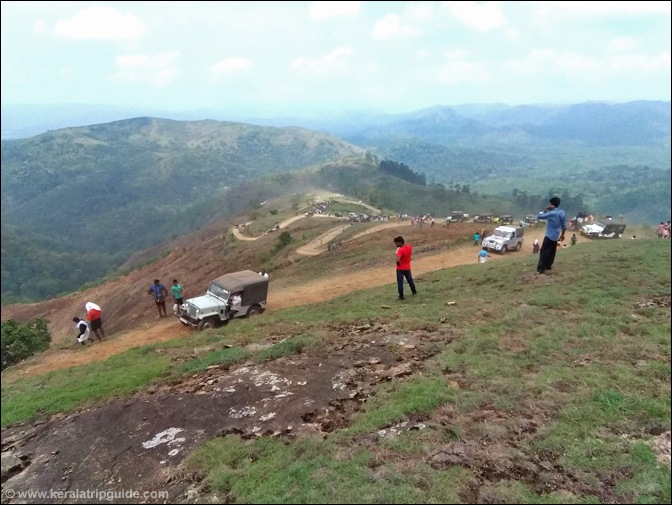
The trail here merges with the trekking path from Tamil Nadu. A steep climb to the right takes you to the entrance of the temple. A giant watch tower is also located here. However, this is not open to the public.
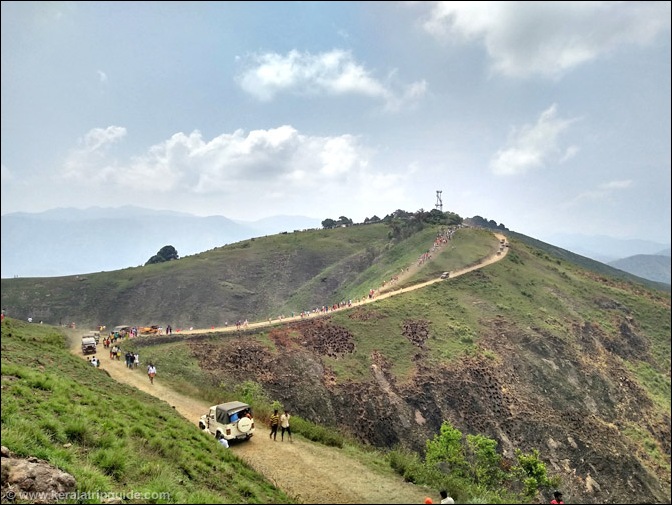
There are multiple stone structures inside the temple complex. The entry to the temple is through a narrow path to the right. There is also a large forest patch behind the temple providing some shade to the tired devotees.
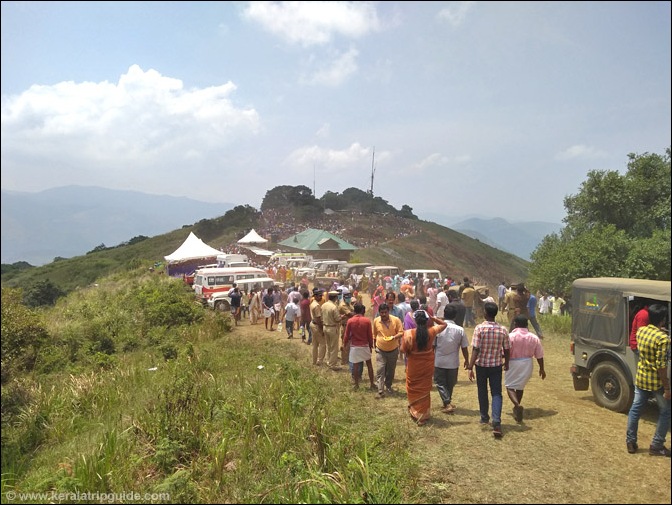
Here are some statistics from the previous Chithra Pournami festivals at Mangala Devi temple,
- In 2017 there were 15,000 devotees visited the place and 516 vehicles conducted around 900 trips to the temple
- In 2018 there were 18,000 devotees visited the place and 553 vehicles conducted around 1200 trips to the temple
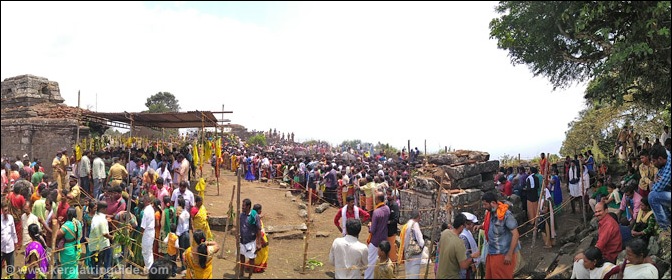
Mangala Devi Temple Trek Report – 2018
I have been hearing a lot about Mangala Devi temple trek from a number of Facebook travel groups. My uncle had gone there in 2017 and he was interested in visiting the place again. With my cousins and brother we formed a team of 5 and decided to trek to Mangala Devi temple from Kumily on 30th April 2018. Since we were coming from different places, we decided to spend the previous night in Thekkady.
I explored a number of stay options in Kumily and finally decided to take two rooms in KTDC Periyar House located in the tourism zone of Periyar Tiger Reserve. What a good thing it turned out! The place is buzzing with wildlife. They have a very nice kid’s park and plenty of space to walk around. The only important thing to keep in mind is that no entry is allowed after 6pm!
The package we took had free dinner and breakfast and hence we decided to start our trek after breakfast. We were ready by 8am. The Periyar house is located around 3km from the Mangala Devi road entrance and getting a transport early in the morning from the tiger reserve is not easy. Luckily we got a KSRTC bus which started from Thekkady at 8am going to Changanassery. The conductor of the bus joked that he thought we were heading to somewhere far away such as Trivandrum instead of the Ambadi junction 3km away! When we told our plan of the trek, he was excited and shared his knowledge of the place and the trek. We got down at Ambadi junction and started our trek towards the temple around 8:20am.
Since there is ownership dispute of the temple between Kerala and Tamil Nadu, police was not taking chances. As per media reports, up to 1000 policemen were deployed on the trekking day! There was heavy police presence across Kumily town and at the Mangala Devi entry gate. Medical teams, fire force, forest department and other government departments had their temporary office at the entrance.
There wasn’t any checking at the initial gate. There were sign boards telling us to get rid of plastic bottles and any other plastic stuff. None of us had any luggage and hence we could just walk ahead. We walked for a few minutes and then came across a second security checkpoint with heavy police presence. First any bags were checked for plastic stuff throwing away anything found in luggage. Next we were asked deposit the camera if we are carrying one! I still don’t understand why they are worried about cameras, since mobile phones are allowed. We Indians seems to have some strange fear of cameras. Along the way I noticed that media men and people with “influence” were carrying cameras! After baggage checking we were asking to walk through a metal detector and finally a policeman did the manual frisking of each and everyone!
Thankfully after this checkpoint, things were mostly normal. At some places we encountered power tripping policemen who were not even allowing trekkers to take the footpath barely few meters from the main jeep road. Since jeeps were plying very frequently, there was lot of dust and it was only commonsense to take the parallel footpath. Most of policemen had no problems, but some power hungry ones were unnecessarily forcing people to walk on the main road.
There were plenty of drinking water pipes along the way. We heard from some folks that the water was not available in the early morning. Anyway we had no issues with respect to water. There were over 6 water dispensing stations located around 2km apart along the way.
The initial part of the trek is pretty comfortable with plenty of shade and cool breeze. This area is actually very close and in parallel to the tourism zone of Periyar tiger reserve. We spotted a number of artificial water ponds along the way created for animals during summer.
After walking for around 5km we across hairpin bends along the road. The road was very bad and jeeps had a tough time navigating this stretch and there was plenty of dust. I had to cover my mouth and nose with a handkerchief. After the hairpin bends we could see the temple and the giant watch tower to our right. From this point onwards trekkers could avoid the main road and could climb the mountain directly. While climbing I noticed a trekking path on the left merging with our path on the top of the mountain. This was the trekking path from Tamil Nadu and plenty of people were coming from that side as well. The trekking trail from Tamil Nadu is shorter at a distance of 7KM. After the merge, we walked to the right towards the temple. We could see the beautiful Cumbum valley on the other side of the mountain. I also noticed that people were climbing other nearby smaller mountains on the way back to get a good view of the valley below.
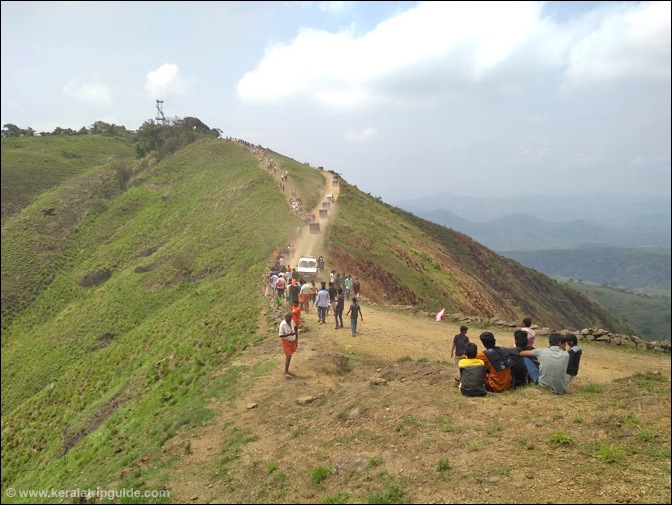
We reached the top around 11am and by this time it was getting very crowded at the top. There was very heavy police presence at the top with most of them resting or sleeping at the shade. There is a large forest patch around the temple, however anyone venturing out to get a shade was asked to go back. Many people were keeping the footwear outside (it was not mandatory) before entering the temple ruins. People were directed to the right side of the temple to enter the temple from the back side. We went around and saw that there was huge rush to get inside the temple. We decided not to enter the temple, but just had a walk around the temple to have a look.
We only had few mangoes with us when we reached top. Thankfully the Kannagi temple trust from Tamil Nadu was distributing free tomato rice to the devotees. We stood in the queue and got tomato rice after few minutes of wrestling. It was delicious!
After spending and hour or so at the top, we decided to walk back towards Kumily. People who came by jeep had a tough time getting a jeep back. Some complained that the police was not helping them to get return jeeps. Many jeep drivers were looking for groups so that they could charge “taxi fee” back instead of the trip fee.
The trek back to the valley was fast and we reached Kumily town around 2:30pm. Luckily the weather during the trek was pleasant with plenty of shade and no rain. When we reached Kumily, we realized that there was heavy rain in the town.
We had food from the Ambadi junction and then took an auto back to Periyar house. We had a quick bath and then went for a walk to the Thekkady boat landing area. We could see a large herd of deer on the other side of the lake. We left Kumily by 6pm.
Mangala Devi Temple Trek Statistics
The elevation profile and the trek timing of our trip is given below. The spurious peaks on the right of the elevation profile can be ignored. As per GPS readings, the highest point of trek is at a height of 1250m. The total distance is approximately 20KM and it took us 6 hours to complete the trip.

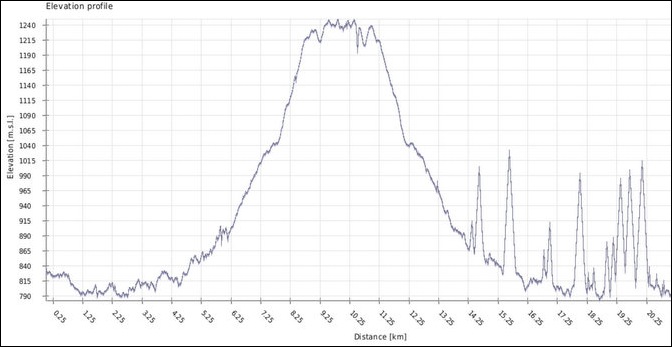
Mangala Devi Temple Trek Tips
- If you have any kind of dust allergy, do not attempt the Mangala Devi temple trek during the festival from Kerala side. Over 1000 jeep trips are conducted in 12 hours throwing up a large dust cloud along the trek trail (The Tamil Nadu trail is free of dust till the last stretch).
- On the trekking day, start early as possible. If you are coming from a far away place, it is better to reach Kumily one day early and stay in a hotel. I recommend starting the trek at 7AM since this avoids the 6AM rush, but you can still complete the trek before afternoon. During the summer months, there is a strong chance of rain and lightning after 2PM.
- Minimize luggage. Avoid carrying any sort of plastic material as it may get confiscated by the forest guards. Do not carry a DSLR, since due to some strange reason they don’t allow DSLR cameras. However, you can carry your mobile. You can also carry a non disposable water bottle. Plenty of drinking water pipes are available along the way.
- You can carry your own lunch (no plastic covers). However, the Kannagi temple trust offers free food (tomato rice) at the top. If you don’t mind standing in a queue and pushing people to get food, you can choose this instead of carrying your own lunch.
- Carry a pollution mask or a good handkerchief to protect against the dust.
- If you don’t mind taking a bus back to Kumily, return through the Tamil Nadu trekking trail to the lower camp (Kumily town is around 5KM from here). This offers a different trekking experience on the way back.
Mangala Devi Trek Summary
The annual Mangala Devi Kannagi temple festival on Chithra Pournami offers a rare opportunity to experience the beauty of the Periyar tiger reserve and Cumbum valley. It also offers you glimpse into the south Indian history. If you are having any kind of dust allergy, attempt the trek only from the Tamil Nadu side.
Additional Resources
May 4, 2018 | Posted in Travel Reviews 1 Comment » | By Jayson


January 5th, 2023 at 1:07 pm
Sir,
I am also from TN Forest Department. We trekked 2 times earlier. Your summary of trekking experience is very nice and informative. Actually we trekked from TN side and returned by jeep which was very dusty . Again we plan to trek 2023 season. Regards